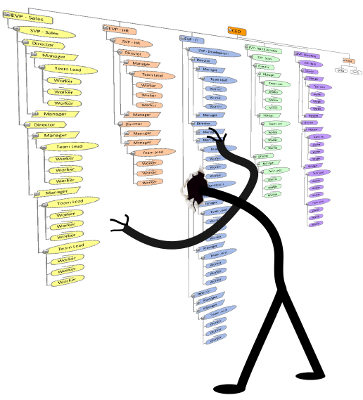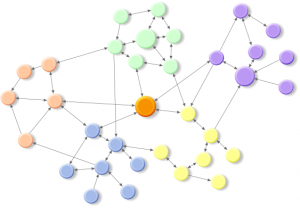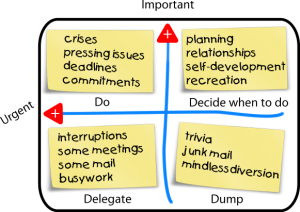by Susan Johnston | Jul 4, 2012 | Uncategorized |
When I was eight years old, my family put me on a bus and sent me to camp for two weeks. I loved it. Living in the northern woods suited me right down to the ground, which happened to be the bare, exposed rock of Quebec’s Laurentian Mountains. I made jewellery boxes out of popsicle sticks, sang campfire songs in parts, swam in water over my head, and slept under the stars. Best of all, I learned to find my way in the woods using animal tracks, the sun, bird songs, the moss on the trees, and the smell of the wind.
Today, I can barely find my front door without a GPS. Time for a refresh.
 So I went to camp again – Agile Coach Camp Canada. This annual event attracts people – mostly from systems development – whose work is to introduce new ways of working. The labels for the type of work they do are “lean” and “agile.” Their goal, as I see it, is to help teams be effective, quickly, without wasted resources. Their processes are highly people-centred.
So I went to camp again – Agile Coach Camp Canada. This annual event attracts people – mostly from systems development – whose work is to introduce new ways of working. The labels for the type of work they do are “lean” and “agile.” Their goal, as I see it, is to help teams be effective, quickly, without wasted resources. Their processes are highly people-centred.
My husband and business partner, who’s part of their world, suggested I come along. “For the drive?” I asked. “No,” he said. “For the conference.” Knowing this man isn’t crazy and trusting his assurance that I’d be welcome even though my geek credentials are limited, I signed on.
I’ve been back home for over a week and I’m still processing all the things I learned. The experience introduced me to some tools that help us find our way. I see real opportunities to apply these ideas and principles in areas beyond IT, particularly in communication. In the next few posts, I’ll be sharing some of them. They are, in no particular order:
To be continued . . .
by Susan Johnston | Jan 27, 2012 | Uncategorized |
I have the great fortune to know a lot of truly cool people in the field of communication. One of them is Donna Papacosta, blogger, writer, speaker, podcaster and social media expert. Donna and I got to talking about Communication Styles. One thing led to another and, next thing we knew, we were doing a podcast on the topic. You can listen here and then do the fun and free assessment, right here on the It’s Understood site.
by Susan Johnston | Jan 7, 2012 | Uncategorized |
At It’s Understood, we have lots of projects on the go. One that’s occupying much of my (Sue’s) time is completing Talk To Me: A User’s Guide To Workplace Communication. I aim to make it available, in February, as a Kindle eBook. (If people like it, we’ll publish for Kobo, iPad, Blackberry Playbook and in traditional book format.)
One of the communication concepts the book tackles is that people have distinct communication styles. Each of us is unique, yet our differences are somewhat predictable.
In my communication coaching, I often use the Myers-Briggs Type Indicator (MBTI) as a starting point in exploring relationships. That reliable and validated assessment is wonderful, but I needed something simpler to use in workshops and presentations. So I created Communication Styles as a way to highlight the different ways people like to receive and share information, especially in conversation. It’s a fun way to discover why individuals respond differently to your message – and to figure out how to present your ideas so they’ll be understood.
We’ve created an online version of the assessment and a special report that explains how it works. You’ll find the link on our web site (look to your right). It’s free. I love that price. Just sign up with your name and email – and have fun.
As a bonus, signing up also gets you our occasional email update “Be Understood.”
by Susan Johnston | Nov 27, 2011 | Uncategorized |
 Here’s a post from Sue’s writing blog that applies to conversation as well as writing.
Here’s a post from Sue’s writing blog that applies to conversation as well as writing.
In my line of work, eavesdropping is research. That may sound like a lame excuse for (rudely?) listening in on other people’s conversations; however, sometimes, they’re simply too loud to ignore. A research opportunity showed up, this week, as I overheard a chat between some people we’ll call Manny and Franny. . .
Read the rest at Sue’s writing site.
by Andrew | Apr 20, 2011 | Uncategorized |
The most common maps of enterprises are hierarchical “organizational charts”. We see them everywhere. We depend on them to illustrate the structural elements of an organization and identify the people working within them. Their underlying organizing principle is top-down granting of authority.
Getting work done in organizations depends on relationships that traverse these artificial boundaries. Collaboration and “cross-functional” teams are a necessary feature of organizational life.
“… understanding how networks work is an essential 21st century literacy.” — Howard Reingold
A critical element of successful communication is knowing your audience. If you need to communicate important information and you’re relying solely on the corporate hierarchy to cascade it from the top, with the attention it deserves, I’d urge you to reconsider. Working with key influencers to craft “viral” messages can have far greater impact. Critical change initiatives need support from critical people. If you can’t identify them you’re flying blind.
The map is not the territory
 If you think your organizational chart represents the relationships that get work done you need to pull your head out the sand (or the chart).
If you think your organizational chart represents the relationships that get work done you need to pull your head out the sand (or the chart).
It’s amazing how much attention is paid to the hierarchy documented in the organizational chart. All of us, when asked, will freely admit that the relationships required to get work done are not illustrated by an org chart.
The reality of the modern organization is that it’s a network. It is the sum of social and working relationships that traverse both organizational silos and levels. The “old boys’ club”, the grapevine, even the smoker’s huddle indicate networks that use informal paths of communication to share trust, knowledge and support.
Organizational Network Analysis
Adopting a network view  is much more useful when it comes to understanding connections between people in organizations. We’re social and form relationships of commitment and trust we need to achieve both personal and corporate goals. This mesh of personal interaction isn’t revealed by an organizational chart but exists nonetheless.
is much more useful when it comes to understanding connections between people in organizations. We’re social and form relationships of commitment and trust we need to achieve both personal and corporate goals. This mesh of personal interaction isn’t revealed by an organizational chart but exists nonetheless.
Working with key or central people within these networks can amplify communication efforts, accelerate change and identify opportunities to promote development. If only we could identify them.
Making invisible connections visible
Tools and processes to do just that are readily available – Organizational Network Analysis or ONA. This type of analysis isn’t a new idea. It’s been used since the 1950s. Pioneers and advocates in the field like Valdis Krebs , Rob Cross and Patti Anklam, among others, have a significant body of experience in making invisible organizational links visible. Growing awareness and analysis of network dynamics has been sparked by internet communities like Facebook and LinkedIn. In parallel, Organizational Network Analysis adoption is finding new advocates. And new providers of tools, analytic software and services like Netview and Keyhubs are emerging.
This is an important and useful tool to consider when thinking about how to make your organizational development or communication initiatives work best.
by Andrew | Apr 7, 2011 | Uncategorized |
“It’s possible,” Tom DeMarco writes, “to make an organization more efficient without making it better. That’s what happens when you drive out slack.”
The myth of efficiency
The relentless pursuit of efficiency has the unintended result of eroding our effectiveness. Daily, our attention is consumed by the immediate and the urgent. Overall the consequence is less time spent thinking as we are consumed by doing. The capacity to think, create and innovate has been driven out of organizations along with the perceived slack. Somewhere along the line “slack” has become a bad thing.

 In his book Slack, Tom DeMarco illustrates the issue clearly with a simple puzzle. The challenge is to move the numbered tiles into numeric order.
In his book Slack, Tom DeMarco illustrates the issue clearly with a simple puzzle. The challenge is to move the numbered tiles into numeric order.
Filling the empty space achieves an impressive 11 per cent ‘efficiency’ gain but renders us incapable of solving the puzzle. We have no room to move. No slack.
The need for reflection
Our brains filter out most of the sensory data we encounter daily. Yet the connections we make between the information that does register don’t always happen automatically. Sometimes we need to think things through to build relevance, connections and insight in response to what we experience. For knowledge workers, in particular, this is critical. Gaining insight from thinking is hard cognitive work. We don’t respect the time and conditions needed to do it well. Interrupting a programmer who is working with a complex mental map of a system is guaranteed to cost time and effort to reconstruct the cognitive state he or she needs to work well.
To a degree, this is influenced by cultural norms. In some countries, a worker sitting quietly at his or her desk, deep in thought, is unlikely to be approached. In North America it’s an invitation to be interrupted.
Stop being busy
The inability to carve out time for reflection can be self-inflicted. We sometimes make poor choices about where to spend the currency that is our attention. A powerful ‘litmus-test’ is a simple question: “Is this useful or merely interesting?“ Pausing to ask this question can steer us to more effective use of our limited attention, time and energy.
Decide where to spend your attention
 So how do we create slack for ourselves? There are many sources of advice on time management and setting priorities. Stephen Covey’s matrix has stood the test of time as a useful approach. Assessing activities by contrasting importance and urgency gives us a visual guide to what’s consuming our attention. Working to spend more time in the upper right quadrant (the reflection space) provides the slack we need to think about how to address the important and urgent events in our lives more effectively.
So how do we create slack for ourselves? There are many sources of advice on time management and setting priorities. Stephen Covey’s matrix has stood the test of time as a useful approach. Assessing activities by contrasting importance and urgency gives us a visual guide to what’s consuming our attention. Working to spend more time in the upper right quadrant (the reflection space) provides the slack we need to think about how to address the important and urgent events in our lives more effectively.
 So I went to camp again – Agile Coach Camp Canada. This annual event attracts people – mostly from systems development – whose work is to introduce new ways of working. The labels for the type of work they do are “lean” and “agile.” Their goal, as I see it, is to help teams be effective, quickly, without wasted resources. Their processes are highly people-centred.
So I went to camp again – Agile Coach Camp Canada. This annual event attracts people – mostly from systems development – whose work is to introduce new ways of working. The labels for the type of work they do are “lean” and “agile.” Their goal, as I see it, is to help teams be effective, quickly, without wasted resources. Their processes are highly people-centred.





